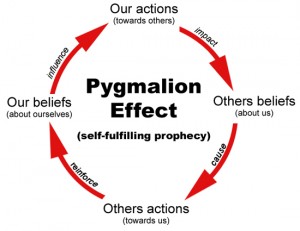“Students Will Rise To the Level of Expectations” ~ Quote from the movie Stand and Deliver
The expression “Students Rise To the Level of Expectation” had to be inspired by the brilliant work by Dr. Robert Rosenthal about the effects of teacher’s expectations on students’ academic and physical performance, the effects of experimenters’ expectations on the results of their research, and the effects of clinicians’ expectations on their patients’ mental and physical health”
Positive Expectations
 What about negative expectations of academic performance for those with speech impairments even before they are old enough to go to kindergarten?
What about negative expectations of academic performance for those with speech impairments even before they are old enough to go to kindergarten?
For a speech impaired child in today’s society who has autism, apraxia, or some other impairment of speech and or language that sadly is still a problem. This is in spite of growing evidence that a child with a speech or communication impairment doesn’t appear to be any more at risk for a learning disability than a child who has a visual or hearing impairment, or any other child today.
Past research in this area, some decades old, has been mainly bleak in regards to academic prowess for those with early speech and language disorders to support the negative stereotype.
The Pygmalion Effect: Robert Rosenthal’s Study on the Power of Positive Expectations
1983 “The ability of four children with developmental verbal dyspraxia to imitate, spell, read and copy regular single-syllable words was investigated. The children were found to have more difficulty in spelling and reading these words than a group of children with normal speech who were matched for reading age. It is suggested that ‘dyspraxie’ children are subject to a phonetic spelling deficit which arises because of a difficulty in segmenting words at a speech-sound level.” Snowling, M, & Stackhouse, J. (1983). Spelling Performance of Children with Developmental Verbal Dyspraxia Developmental Medicine and Neurology, 25, 430 – 437.
1992 “It is argued that, while young children make use of a phonological frame on which to organize orthographic information, dyslexics, like JM, who have inadequate phonological representations, are unable to do so. This has a detrimental effect on their acquisition of spelling.” Continuities between speech and spelling in a case of developmental dyslexia” Margaret Snowling, Charles Hulme, Bill Wells and Nata Goulandris Humanities, Social Sciences and Law Reading and Writing Volume 4, Number 1, 19-31,
And despite various documents one can find easily, delayed or impaired speech in preschool years is viewed as a risk of a learning disability. And if that child has a motor speech impairment such as apraxia or dyspraxia, supposedly the link is stronger.
For example below are warning signs of a learning disability from a page called “The Warning Signs of Learning Disabilities. ERIC Digest. (which could just as easily be titled ‘The Warning Signs of Apraxia / Dyspraxia”!)
The Warning Signs of Learning Disabilities. ERIC Digest
Language
- Slow development in speaking words or sentences
- Pronunciation problems
- Difficulty learning new words
- Difficulty expressing wants and desires
- Difficulty rhyming words
- Lack of interest in story telling
Motor Skills
- Clumsiness
- Poor balance
- Difficulty manipulating small objects
- Awkwardness with running, jumping, or climbing
- Trouble learning to tie shoes, button shirts, or perform other self-help activities
- Avoidance of drawing or tracing
There are fortunately contradictions to these supposed LD warning signs, which include current research and anecdotal evidence.
Recently published research examining speech impairment and literacy risks:
 2011 “Although children with speech impairment are at increased risk for impaired literacy, many learn to read and spell without difficulty”
2011 “Although children with speech impairment are at increased risk for impaired literacy, many learn to read and spell without difficulty”
The relationship between speech impairment, phonological awareness and early literacy development Judy Harrisa, Nicola Bottinga, Lucy Myersa & Barbara Dodda* Australian Journal of Learning Difficulties 04 Jul 2011
In addition in the past ten years through the various online support groups of the Cherab Foundation overwhelmingly member’ childrens were mainstreamed in school and reportedly good students. Today for one example the iPad and it’s various apps to help those with speech disabilities is one technology that has leveled the playing field as a way for a verbal disabled student to prove that just because one can’t speak doesn’t mean they aren’t able to think and learn.
The second recent change is not high tech, but back to basics. It has been found providing essential nutrients is critical for healthy brain function.
Nutrition
According to the Society for Neuroscience, Diet and the brain, from March of 2003, studies revealed that diets with high levels of saturated fats actually impair learning and memory. That was a decade ago! Since then there is a growing wealth of research that links poor food choices to impaired learning and lower IQ, and healthy food choices to improved memory, cognition, and higher IQ.
In spite of solid research, and outreach to raise awareness by various organizations including First Lady Michelle Obama’s ‘Let’s Move’ program, and Harvard’s School of Public Health’s new Healthy Eating Plate, poor food choices remain a staple for most children and families.
Our key note speaker at the First Apraxia Conference ever hosted by the Cherab Foundation was Dr. Hugo Moser who led the trials to validate Lorenzo’s Oil and was featured as the doctor in the movie of the same name. He banged his fists on the podium and bellowed “RESEARCH NEEDS TO BE DONE IMMEDIATLY. DON’T WAIT!!” Dr. Moser probably was so passionate because it took ten years to validate Lorenzo’s Oil. Many children could have been saved but weren’t because there was such deep skepticism against what Lorenzo’s parents were doing by some organization that was supposed to be for support.
While we haven’t had specific research done for our population of speech impaired, Dr. Hibbeln who oversaw the professional anecdotal results from our group has published numerous papers on the importance of the essential fatty acids for healthy brain function. Here is just a few of many examples of where his work is quoted:
“Low maternal fish intake was associated with increased risk of children being in the lowest quartile for verbal intelligence quotient (IQ), and increased risk of suboptimal outcomes for fine motor skills and communication/social development scores (Hibbeln, 2007). Hibbeln et al (2007) estimated incidence of suboptimal verbal IQ in children eight years of age as a function of maternal seafood consumption during pregnancy in 11,875 women. Children of mothers reporting the highest seafood consumption were significantly less likely to score in the lowest quartile for verbal IQ compared to women who reported no seafood consumption during pregnancy.” Read more here
“Indeed, prenatal deficiency of omega-3 fatty acids can lead to mental retardation. In one study, researchers interviewed 11,875 women during the third trimester and later tested their children’s cognitive abilities. Mothers who avoided seafood were more likely to have children with fine motor deficits, communication problems, poor social behavior and low verbal IQ…” Read more here.
More recently in addition to fish oils, we’ve noted even greater gains in academics with the addition of foods rich in the essential amino acids and other nutrients.
Preschool Concerns
Children with severe impairments of communication like apraxia may have inconsistent ability to recognize or point out various letters, numbers. This is asked about quite frequently in our private groups and a huge area of frustration for us, the parents. For this area of lag advice from SLPs say our children are working on basic language and in some cases motor and other skills as well, so just continue to share with them the correct answer and just give them more time while they continue to work on other areas of development. Also it’s not clear if they ‘don’t’ know the answer vs. can’t share what they know due to a motor or other impairment in their body.
School age: speech impaired students, again even where in most cases they are mainstreamed and good students, there can be lags in reading and writing. Dr. Renai Jonas CCC SLP presented for the Cherab Foundation to the SSA office in Washington DC at an conference that speech impairments such as apraxia, while not childhood or developmental conditions, can create developmental lags in language which differs from an impairment because there will be more than a year’s gain in a year’s time. So even in older students some may not be aware that an impairment can create developmental lags and in these cases the student shouldn’t be labeled as having a secondary language impairment until developmental lags from the speech impairment are ruled out.
A few years ago I spoke to Dr. Rosenthal and he told me that his research on self-fulfilling prophecy was always done to the positive for ethical reasons. I told him that in the Alfred Hitchcock world we live in that research on negative self-fulfilling prophecies for children with speech delays and impairments even in preschool years is being done by society. I told him that the expectations were validated as much of the cognitive and receptive testing for children with speech impairments is based on verbal based IQ tests.
I asked Dr. Rosenthal, “They would never use visual based IQ testing for a visually impaired student or auditory based IQ testing for a hearing impaired student, so why would they use verbal based IQ testing for students that are verbally impaired?” “Dr. Rosenthal answered, “I don’t understand. Why aren’t they using nonverbal testing?” And I laughed and said “You are one of the top psychologists in history. If you don’t understand I don’t believe anyone would!”
In addition to this according to the US Department of Civil Rights through the US Department of Education it’s illegal to judge a child’s ability on their disability.
Benefit of the Doubt in Testing
Summary of assessment procedures Children with significant language and motor skills delays by Robert E. Friedle, Ph.D. Clinical/Neuropsychologist
Formalized assessment of children with low incidence disabilities does not often provide accurate or practical information about their cognitive functioning skills. Such assessment does provide evidence that these children often have not learned how to respond in direct one-to-one reciprocal testing situations, or that they are unable to respond in those situations due to the nature of their disabilities. The lack of response should not be considered then, necessarily, as a global and fixed delay in cognitive/intellectual potential. Developmental theorists and practitioners have long known that cognitive growth is not only enhanced, but also dependent upon opportunities to experience a wide variety of sensory stimuli in an interactive relationship. Problem solving skills, analytical reasoning, and decision-making are all formalized, cognitively, when integration of information is ongoing. Language and motor skill limitations often prevent the integration and experiences and thus certain cognitive growth waits until such experiences may be provided.
Children may have learned to problem-solve and reason in ways that are not assessed by formalized evaluations and are only recognizable when the child is allowed to experience sensory information in a manner most productive to them. It is often then necessary for the examiner to assess what opportunities and experiences the child may have had already, how an assessment may prompt the child to show what they can do with various stimuli and how problem solving, analytical, and decision making skills can be exhibited by a child in a non-formalized approach.
formalized evaluations and are only recognizable when the child is allowed to experience sensory information in a manner most productive to them. It is often then necessary for the examiner to assess what opportunities and experiences the child may have had already, how an assessment may prompt the child to show what they can do with various stimuli and how problem solving, analytical, and decision making skills can be exhibited by a child in a non-formalized approach.
The purpose of an assessment request has to be relevant to the child and to their experiences, i.e. the child needs to see some purpose for providing a response. A very simple example of this premise is: asking them to name an object may result in no response, but asking them to get the object may show a knowledgeable response.
Children with language and motor deficits often play within the restrictions that their limitations have presented and this “changed” pattern of play, from what is seen with non-disabled children, can be a direct reflection of their ability to problem solve and reason in play. An example for this may be when a child finds that laying things down and flat makes it easier to manipulate, or that moving things closer or out of the way facilitates motor planning and play. Often the child may see no purpose to expand experiences, or have not figured out independently how to change their play patterns.
Restrictions in movement or language limit the experiences a child has had with objects and stimuli. The need to practice simple movements, to hear the words that go along with those movements, and then to ask a child to duplicate the movements and/or the words can greatly facilitate cognitive growth. If a child can readily make such duplicated responses then the potential for cognitive growth at that point presents no limitations. An examiner can lead the play situation in these types of activities and note the ability of the child to engage in the “play” at a different level. The purpose is then presented clearly for the child, both for the language and for the movement, and thus becomes an active part of their developmental growth and understanding. Sometimes showing them or asking them to change their approach results in a larger perspective of possibilities in play. The examiner is an active participant in the assessment approach, engaged with the child in the semi-directed play type of assessment. The examiner notes closely when a child shows a lack of understanding of the language presented or an inability to make the movements requested. At all times the examiner is assessing how well the child appears to follow the purpose of the activity or the change in direction of an activity.”
With or without a diagnosis however you can still use the severity intervention matrix guide used by the schools to determine how much therapy a week is needed based on severity.
Bring positive academic expectations up! After a childhood speech impediment left him struggling to read, Jordan learned strategies from world leading speed readers to dramatically enhance his reading ability. Jordan now helps others unleash their potential to learn anything faster. Because he knew that spending hours reading books and watching seminars was not as effective as it could be.
t>
More Information
- Speech Therapy Matrix
- Addressing Apraxia of Speech in the IEP
- Notes From A Warrior Mom For IEPs
- Nationwide list of Parent Training and Information Centers
- Nationwide Protection and Advocacy Organizations
- Dealing with IEPs for a Speech Impaired Child
- IEP Goals, Objectives, and Sample Letters to Teachers
- The Pediatrician’s Role in Development and Implementation of an Individual Education Plan (IEP) and/or an Individual Family Service Plan (IFSP)
- Information From Our Group To Help Those With Apraxia, Autism, And Other Special Needs
- Sample Letters To Your Child’s New Teacher
- Research Reasons To Delay Kindergarten
- ASAH The Private School Option For Students With Disabilities
- New Awareness Video From The Learning Disabilities Association of America (LDA)


